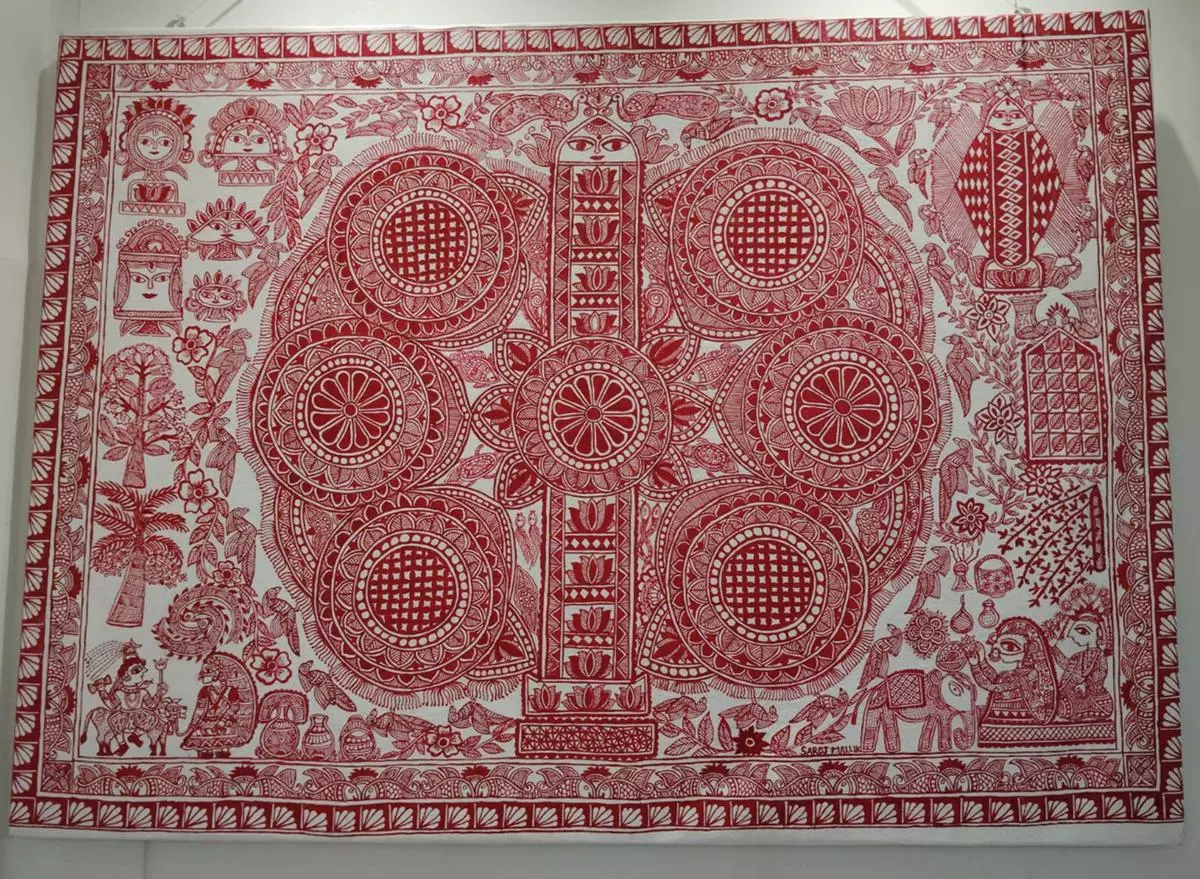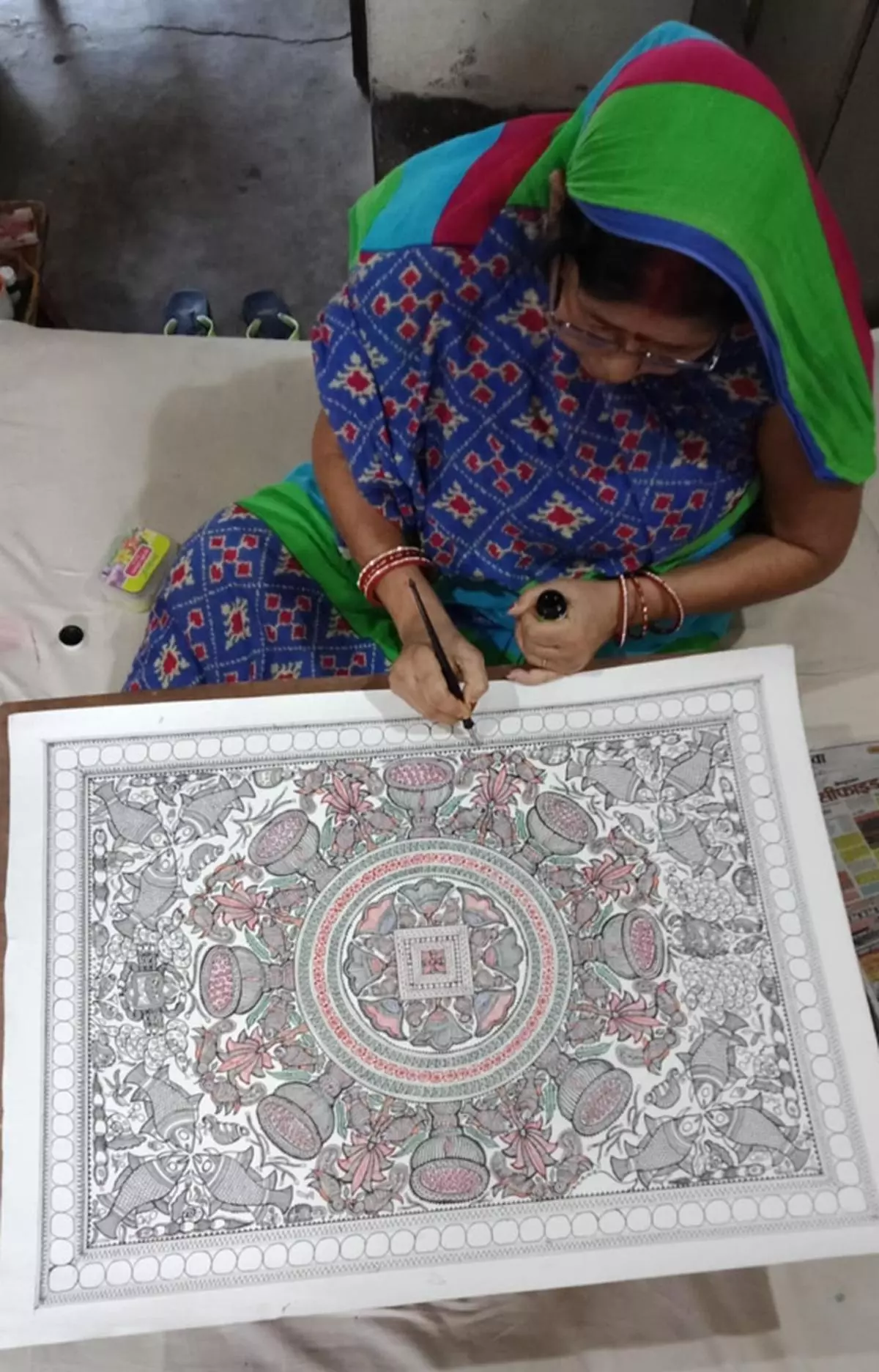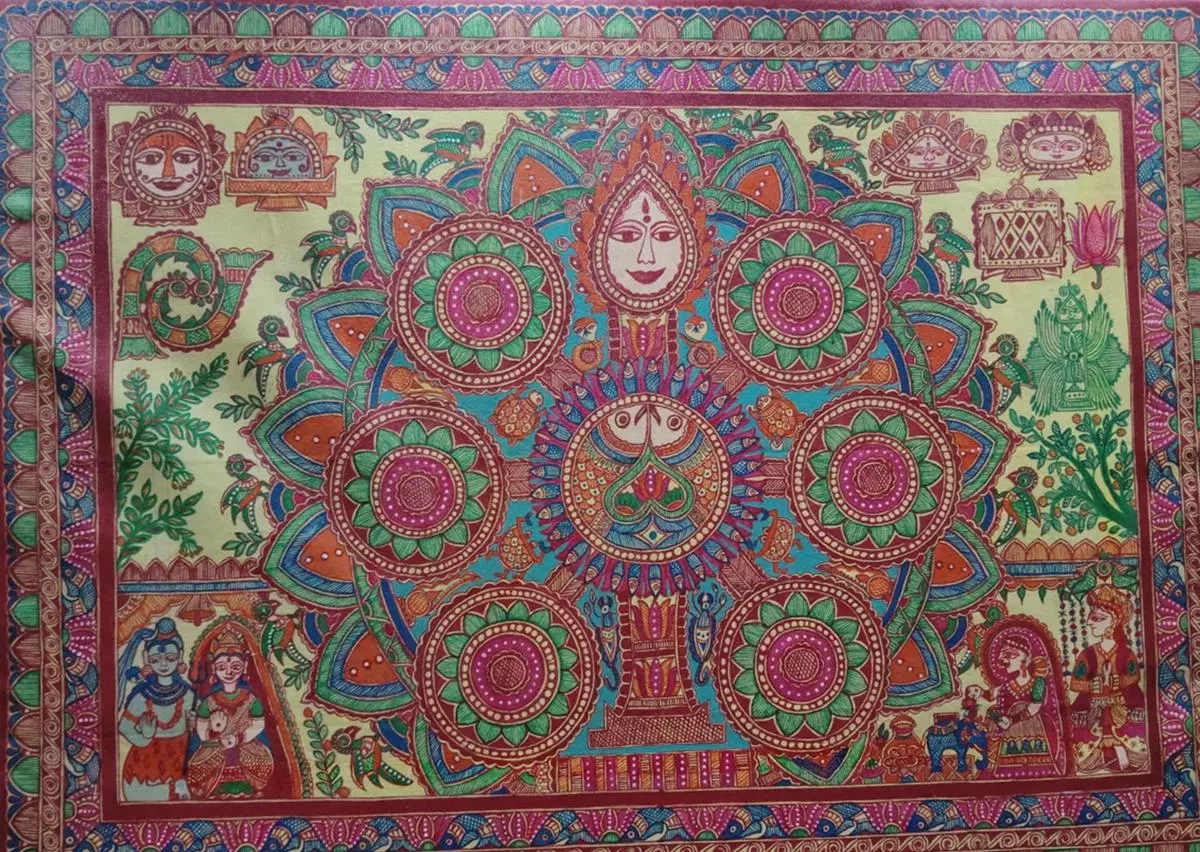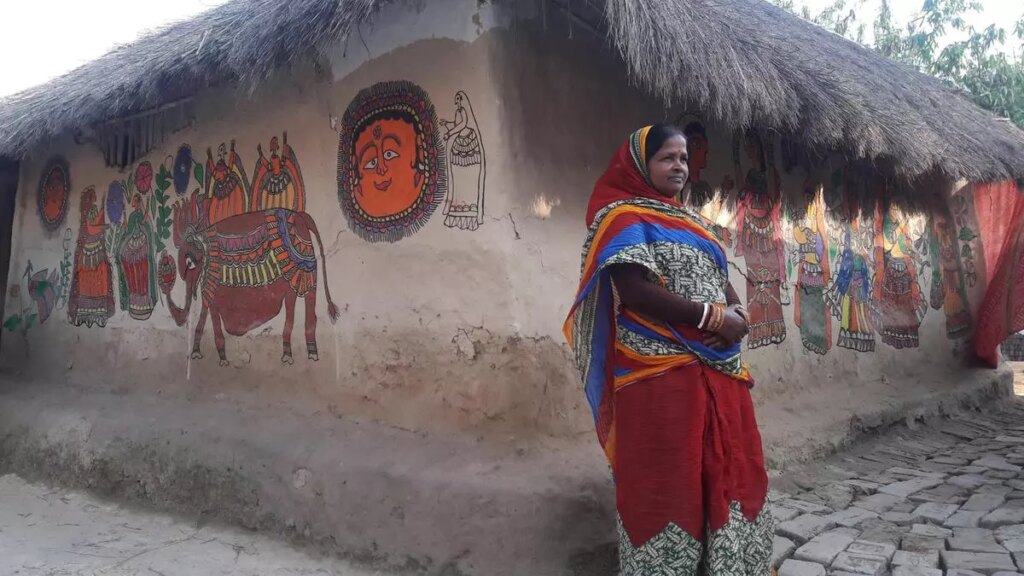It is a typical December morning in a village in Madhubani district of Bihar: chilly, foggy, and hazy, with meadows, weeds, and plants along the kachcha lanes glistening with dew. In the quiet of the cold morning, one can clearly hear the croonings of women coming from the haphazardly built houses. There is a wedding in the village, and the women are singing while drawing the lines and imageries of Kohbar on the walls of the Kohbar ghar, or nuptial chamber. The songs speak of the love of Ram and Sita.
“This is the wedding season [November to January and then again, May to June] in the Mithila region, and in almost every village, you will hear women singing as they draw Kohbar. The wedding in our village is just a few days from now, so the women are hurrying to finish the Kohbar motifs. They must have started working early in the morning,” said Vineeta Mallick, a Kohbar-maker from Madhubani who runs an organisation for preserving Maithili heritage, Mithilangan.
In the Mithila region (consisting of parts of Bihar, Jharkhand, and Nepal), Kohbar is an essential part of weddings. “The groom is supposed to marry the Kohbar first. He will put vermilion on the painting, and only then can he marry the girl,” Mallick explained.
Also Read | Patachitra: Ancient storytelling tradition finds new life in contemporary art and commerce
The ritualistic painting of Kohbar is chiefly associated with communities like the Karna Kayasthas and the Brahmins of Mithila. It was originally drawn on the mud walls of the Kohbar ghar, where the bride and groom would spend four days after tying the knot. Women from the bride’s family would start drawing Kohbar in the nuptial chamber as soon as the wedding date was finalised. Later, relatives and neighbours would join in.

The basic design of Kohbar created on the walls of a Kohbar ghar for a wedding.
| Photo Credit:
SYAMAL DAS
The art traces it origin to the time of the Ramayana. It is believed that King Janak, the ruler of ancient Mithila, got Kohbar designs created on the walls of the Kohbar ghar of his daughter Sita when she got married to Ram at Janakpur, which now falls in Nepal. Kohbar still continues to be a part of life in Mithila, mainly in the districts of Bihar like Darbhanga, Madhubani, Purnia, Saharsa, Sitamarhi, and Supaul. Most women from the Karna Kayastha and Brahmin communities are familiar with the patterns.
Motifs from nature
The basic design of Kohbar consists of a lotus at the centre with a bamboo stem emerging from it. On either side of the lotus bloom, there are seven round leaves connected to one another. At the top of the bamboo shoot, there is a human face. There are images of Siva and Parvati along with motifs of the sun, moon, and planets in the topmost section of the frame. These are accompanied by images drawn from nature, such as trees of jackfruit and banana, fish in pairs, turtles, snakes, parrots, peacocks, and bamboo groves. At the bottom of the frame there are images of rituals believed to have been performed at the wedding of Ram and Sita such as the swayamvar, the Gauri puja, the bride’s worship of Siva, and the bidai (farewell), showing the bride leaving her father’s home in a palanquin.
Rama Das, a senior Kathak exponent from Madhubani and a connoisseur of Kohbar art, said there was a time when all the walls of the nuptial chamber would have been covered with Kohbar designs. “I have been drawing it too but mostly on handmade paper. My very first work was noticed by a music lover from Germany, who visited us in the 1980s to discuss the history of the Darbhanga-Amta gharana of dhrupad with my music-historian and sarod-player father, Prof. C.L. Das. He was so fascinated with Kohbar that he took home all my artwork,” she said.

Kohbar art is now made on handmade paper. Bibha Das, a national award-winning Maithili painter, works on a drawing in Ranti.
| Photo Credit:
SYAMAL DAS
However, as times change, and along with them, wedding rituals, Kohbar art is also mutating. These days, when most weddings are being held in rented halls and hotels, Kohbar art is no longer made on walls but on handmade paper and on pieces of cotton or silk, which are then spread over curtains. It is also done on canvas.
Maithili art enthusiasts are worried that Kohbar may not survive the changes. “For centuries, Kohbar ghar and Kohbar art have remained indispensable parts of wedding in our community. But the very pattern of weddings is changing now. Hotels and wedding halls can hardly accommodate rituals like Kohbar,” said Alka Das, a Maithili painter, and Sarita Das, a Kohbar-maker from Madhubani who is also a member of Mithilangan.
Lack of space
Bhairav Das, convenor of the Patna chapter of the Indian National Trust for Art and Cultural Heritage, said: “Mithila cannot but be affected by the winds of change. Many of the Karna Kayastha and Maithili Brahmin families who were once based in the rural areas of north Bihar have now migrated to urban centres in search of employment. They live in rented houses or flats, which have no space for elaborate wedding rituals. When they rent halls for wedding, they use Kohbar on cloth or canvas. We cannot say how long the tradition of Kohbar will survive.”

Kohbar on canvas.
| Photo Credit:
SYAMAL DAS
Chandana Dutt, a Kohbar-maker and schoolteacher from Ranti village, Madhubani district, said that the concept of Kohbar ghar is also under threat now. “It was a ritual meant to acquaint the bride and the groom with each other at a time when they were not supposed to have met before the wedding. Now, when they spend a lot of time together before marriage, the concept of Kohbar ghar has become redundant. For the present generation, Kohbar art too is trite and old-fashioned,” she said.
Missing purity
While the original form of Kohbar is in jeopardy, its commercial variants fetch a high price in national and international markets. Nowadays entire families, including men, can be found creating Kohbar pieces when the art was once the preserve of women.
Bimala Dutta, a national award–winning octogenarian Maithili artist who has displayed her work in Nepal, Japan, France, and the US, pointed out the significance of Kohbar art. “Kohbar is not just a form of painting. Each image and motif in Kohbar implies a particular aspect of life of the newly married couple,” she said. For instance, the lotus bloom and the bamboo stem are phallic symbols, indicating procreation. The sun stands for brightness and prosperity; the moon symbolises love and peace; the navagraha (new house) is a symbol of stability; the jackfruit tree is for blessing; the pairs of fish, parrots, and peacocks are for love and bonding; the turtle denotes long life; and the serpent is meant to warn the couple of negative influences in their life. “The original pattern must be followed to keep the tradition intact. There must be seven or nine round leaves around the lotus petals, neither more nor less,” Dutta said.
Also Read | Young artists drive debut Bengal Biennale’s democratic vision
Artists have also started taking liberties with the design. “I had never seen the image of Ganesh in Kohbar painting. But you find it in many Kohbar pieces now,” Dutta said. The artists may not be aware of the original Kobar pattern, she pointed out. “There’s also the possibility that they are trying to be market-savvy. In any case, this is not pure Kohbar art,” she said.
Is the government making any effort to preserve the tradition? Bhairav Das said: “Kohbar has always been a strictly family affair. But since it is at the risk of changing, efforts must be made to keep the original pattern intact.”
Reena Sopam is a journalist and author from Mithila who writes on culture, music, and heritage.
Source:https://frontline.thehindu.com/arts-and-culture/heritage/bihar-kohbar-art-maithili-wedding-tradition-ramayana-ram-sita/article69229518.ece

